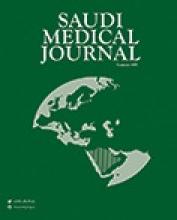Abstract
OBJECTIVE: The present study aims to define the pattern of bacteremia with clinical sepsis in diabetic patients at King Abdul-Aziz University Hospital (KAUH), Jeddah, Kingdom of Saudi Arabia (KSA), in relation to the type of infection, microbial pattern, source, complication, outcome, and the risk factors associated with high mortality.
METHODS: Retrospective study of adult diabetic patients with bacteremia and septicemia admitted to KAUH during a 2 years period between January 2000 through to December 2002 was carried out.
RESULTS: A total of 4850 blood culture were submitted to the Microbiology Laboratory of KAUH over a 2 years period. Two hundred and ninety (6%) cases had positive blood cultures, 70 were diabetic patients with an incidence rate of 24% with p-value of 0.043 which is statically significant. Urinary tract infection was the most common source of bacteremia in our study group with Escherichia coli as the most frequent organism in 62%. Mortality rate was 44%. Old age was an important risk factors for high mortality with p-value 0.011, which is statically significant. Other risk factors included comorbidity associated with diabetes, septic shock, mechanical ventilation and disseminated intravascular coagulation.
CONCLUSION: Increase age was one of the important risk factors for high mortality rate in our study group. Good empiric antibiotics coverage should be instituted early in high risk groups.
- Copyright: © Saudi Medical Journal
This is an open-access article distributed under the terms of the Creative Commons Attribution-Noncommercial-Share Alike 3.0 Unported, which permits unrestricted use, distribution, and reproduction in any medium, provided the original work is properly cited.






